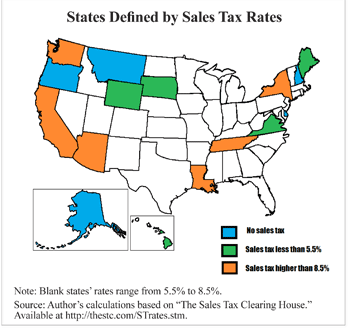Internet sales accounted for a growing share of consumer spending over the last decade. Now smart phones and wireless networks provide an almost unlimited ability to shop and purchase goods electronically. Though consumers benefit from this technology, “brick-and-mortar” stores are losing market share to “remote” competitors.
For instance, in 2012, Internet sales on the Black Friday following Thanksgiving Day reached a record-setting $1 billion.
Most consumers do not pay sales taxes for online purchases because of the 1992 Supreme Court Quill v. North Dakota ruling that a remote business can only be forced to collect a sales tax if it has a physical presence in that state. The states say the absence of physical presence is a tax collection discrepancy that allows online retailers to sell products for less than the brick-and-mortars. The National Conference of State Legislatures estimates this tax discrepancy will cost states $23 billion in avoided taxes in 2012.

The “Use Tax.” The use tax was the first attempt by states to close the discrepancy created by the Quill decision. The use tax requires consumers to pay sales taxes to their state for all goods they purchase, whether the purchase occurred online or in brick-and-mortar shops. This shifts the burden of paying the tax from businesses onto consumers — who are generally unaware they are required to pay the tax.
Congress could override the Quill decision, so long as interstate commerce is not burdened with “a virtual welter of complicated obligations” from multiple tax jurisdictions. As of July 2011, there were almost 9,600 separate sales tax jurisdictions in the United States, including cities that impose their own tax rates — all with varying rules, rates and exemptions. The software needed to comply with these thousands of tax rules barely exists, and is often faulty and expensive. The burden on small online retailers of complying with 50 state tax regimes is a de facto barrier to entry and gives local retailers an unfair advantage.
“Destination-Based” Taxation. Some members of Congress and state governors favor a destination-based sales tax rule. The sales tax would still be collected by the seller, but the tax would be paid to the buyer’s state. Under current law or the destination rule, states would only collect sales taxes from brick-and-mortars that operate in that state. But the destination rule would require online retailers to verify buyers’ home sales tax rates, creating a two-tiered system in which businesses are treated differently based on their business model. But it is not “leveling” the playing field to require online retailers to collect sales taxes for all states, at great expense, while not requiring physical stores to do so. This system would subject business owners to the laws of states where they do not reside, whose governments are unaccountable to them. Moreover, consumers would not have a choice of making purchases from competing states.
The destination-tax plan will only work with uniform tax rates and streamlined collection systems because of the complications of so many jurisdictions and tax codes. In fact, the destination-based rule essentially expands the Streamlined Sales and Use Tax Agreement (SSUTA) among participating states. The SSUTA has been implemented in 24 states, but this will not resolve the online sales tax discrepancy unless the physical-presence rule is replaced with a destination-based rule.
Furthermore, the physical-presence rule assumes the business collecting a sales tax receives a benefit from government, such as protection by the local fire department. However, a business in one state that collects a sales tax from a consumer in another state enjoys no such benefit. Some commentators refer to SSUTA as a cartel because it allows states to shift their tax burden from local stores to online retailers.
“Origin-Based” Taxation. The physical-presence rule does not address the disparate sales tax treatment of Internet sales. An alternative approach is an origin-based rule. This rule would essentially leave the physical-presence standard in place while mitigating the disparity between online sales and brick-and-mortar sales.
Under an origin-based rule, all transactions would be taxed according to the seller’s location. Online retailers need only know their local sales tax laws and would not remit taxes to other states. Because state sales tax rates vary [see the figure], an origin-based rule would also promote competition among high- and low-tax states.
A “Flat Tax” Solution. Another approach would be to replace sales taxes with a consumption tax. Only about half of all consumption is subject to sales taxes, according to Tax Policy Center economist William Gale. States exempt many goods and services from their sales tax, and thus require a higher rate to generate the same revenue as a lower rate without exemptions.
By contrast, a consumption tax, such as a flat-rate income tax, would reach all consumption spending. The purchase prices of consumer goods would reflect the burden of the tax, regardless of where the buyer resides or where she purchases goods and services. Thirty states already piggyback on the federal tax system. States could piggyback on the federal flat tax and this could replace their current sales taxes.
Irene Switzer is a legislative assistant with the National Center for Policy Analysis.